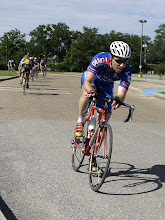On the outset, we consider riding a bike as simplistic and rather juvenile when compared to other activities such as skeet shooting, pole vaulting or javelin throwing. I would venture that we have this perspective because "anyone can ride a bike". After all, we've ridden a bike since before we can remember, "It's just like riding a bike".
Here's a paraphrase from Moshe Feldenkrias who wrote "Awareness through movement". In his book, he contends that people move in patterns that are not productive. They keep muscles tense that are unnecessary. As a result, often times, they develop pain syndromes and/or loose functionality without even being aware of the cause of the problem. He goes on to say that unless there is some sort of mechanism to monitor proper motion, it will remain unchanged. If you ask me, these are pretty powerful statements when you begin to apply them to our sport.
If we apply these principles to cycling, basically, we will get on the bike and pedal it down the road. If the bike moves down the road, that is "good". If it falls over, this is "bad" and we would correct our movement pattern now because falling becomes the mechanism of determining success or lack of success. However, as a general population, we are easily satisfied. If the bike rolls down the road, that must be good. If I want it to roll down the road faster, we should do whatever we are doing either faster or harder. Wow! Seems simple. Unfortunately, we fail to ask the question. "Could we do it better?"
Back to Feldenkrias. If you are going to do some thing better, you need a mechanism to monitor your movement activity. You need benchmarks.
Purchasing speed only gives reward to a point. Let's face it, bikes are only going to get so light, bearings so smooth, wheels so aerodynamic etc, etc, etc. Then what? It's at this point, that you either run out of money or technology suggests that you purchase a motorized cycle if you want to go faster. Where do you invest at this point?
It's time you invest in you. It's time that you take a look a what you are doing so that you can do things better instead of harder or faster. Here's the reality. It's easier to try to purchase speed than to develop speed. Developing speed takes effort, suffering and discipline. It does not come easy. However if you do it and focus on you, the engine, you will be faster and the cost will be less in the long run.
Here's the great thing. Once you start riding faster, you are less concerned with the latest and greatest gadget. You become concerned with things that have the highest value.
Riding a bike fast is not a secret.
Purchase a quality bike that fits you(something between $800 and $10,000)
Get fit properly on the bike
Learn how to pedal the bike
Train effectively
Eat good food on and off the bike
Get good sleep
Love what you do
Tell others about it
Wow! That looks easy.

